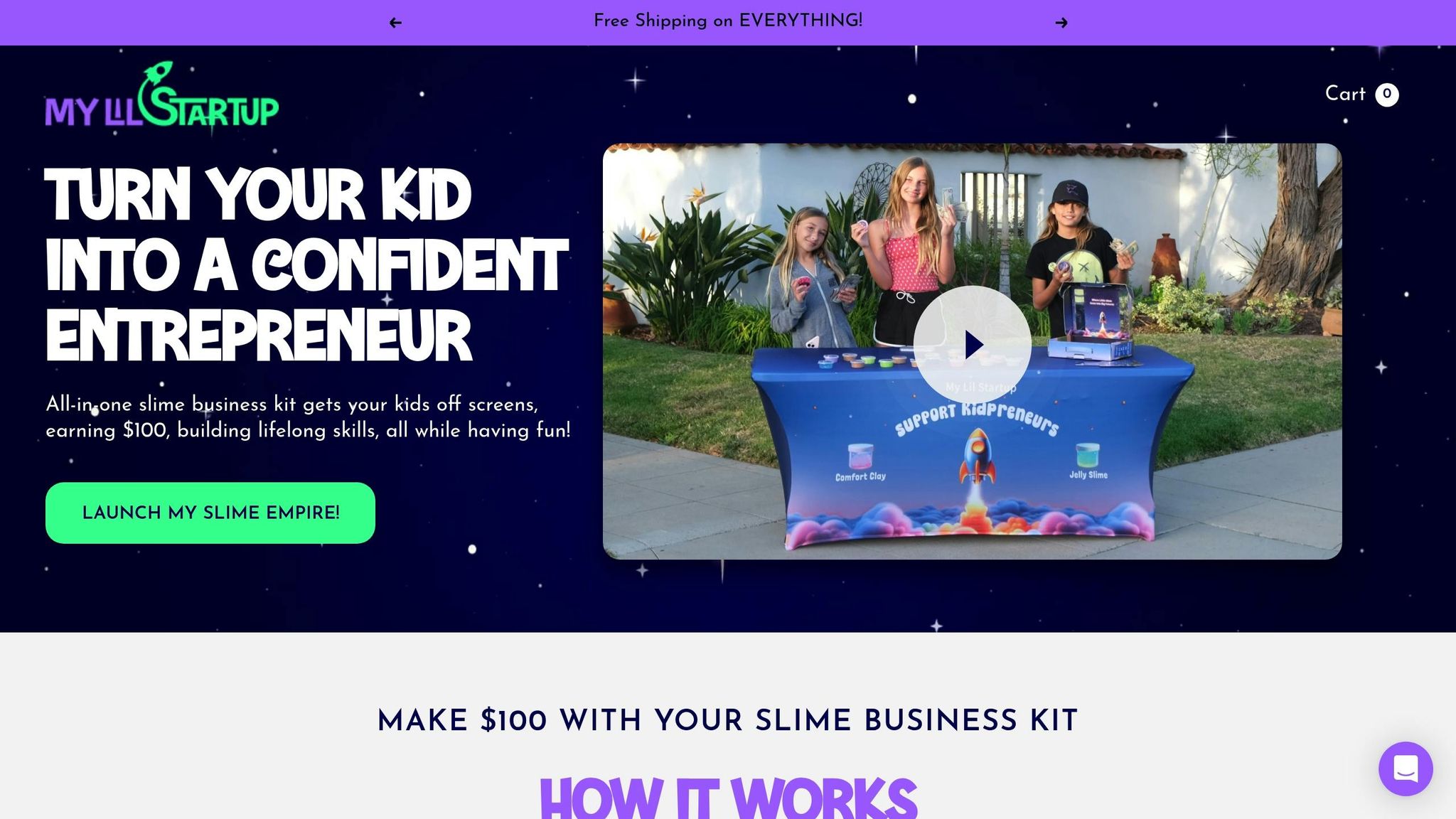Allergic reactions to slime are common, especially in children with sensitive skin. Issues like rashes, redness, and itching often stem from ingredients like borax, preservatives (MCI/MI), and fragrances in both homemade and store-bought slime. Homemade slime poses higher risks due to undiluted chemicals, while store-bought options are generally safer but still contain allergens. To protect your child:
- Choose safer options: Look for non-toxic, allergen-free products.
- Limit exposure: Use gloves, keep play sessions short, and supervise younger kids.
- Spot reactions early: Watch for redness, itching, or swelling and stop use immediately.
If symptoms persist or worsen, consult a doctor. Prioritize safety by reading labels, practicing good hygiene, and opting for pre-made slime kits with safe ingredients.
Parent Issues Warning After 11-Year-Old Daughter Suffers Burns While Making 'Slime"
Ingredients in Slime That Cause Allergies
Knowing which ingredients can trigger allergies is key to protecting sensitive skin, especially for children. Both homemade and store-bought slime can contain chemicals that might lead to allergic reactions.
Problem Ingredients to Watch For
Some common allergens found in slime come from preservatives and additives often used in household products. For instance, methylisothiazolinone (MI) and methylchloroisothiazolinone (MCI/MI) are preservatives frequently found in glues and detergents. Parabens, such as methyl paraben and ethyl paraben, are another group of ingredients that can cause issues.
Fragrances are also a well-known source of allergies. Research shows that fragrance compounds are a common trigger for allergic reactions. Ingredients like borax and boric acid, which are staples in many homemade slime recipes, pose additional risks. Repeated exposure to these can even result in chemical burns. Another concern is formaldehyde releasers found in certain glues, which can lead to severe allergic responses. Lastly, propylene glycol is another ingredient that can cause significant skin irritation in children with sensitivities.
These allergens are not unique to slime - they’re present in many everyday household products. Understanding these potential triggers helps set the stage for comparing the risks of homemade versus store-bought slime.
Homemade vs Store-Bought Slime Risks
When comparing homemade slime to store-bought options, the risks often come down to how the products are made and what ingredients are used.
Homemade slime tends to carry a higher risk because it often involves undiluted household chemicals. Kids making their own slime might use full-strength glues, detergents, and borax without proper dilution, increasing their exposure to harsh irritants. Many DIY recipes rely on products that aren’t meant for prolonged skin contact, such as laundry detergents, contact lens solutions, and household glues. This can lead to immediate skin burns or long-term allergic reactions.
Store-bought slime, on the other hand, is generally safer. These products typically go through safety testing and are formulated with lower, regulated concentrations of potentially harmful ingredients. While commercial slime may still contain allergens like isothiazolinones, parabens, or fragrances, manufacturers are required to list these ingredients and follow safety standards.
Here’s a quick comparison of the risks:
| Risk Factor | Homemade Slime | Store-Bought Slime |
|---|---|---|
| Chemical Concentration | High (undiluted products) | Lower (regulated amounts) |
| Ingredient Disclosure | Limited (household products) | Required by law |
| Safety Testing | None | Required |
| Allergen Risk | Very High | Moderate |
For a safer alternative, consider options like My Lil Startup's Slime Business Kit, which uses non-toxic, natural ingredients. These kits take the guesswork out of slime-making and avoid the dangerous chemical mixing often involved in homemade recipes.
One notable issue with homemade slime is the unpredictability of ingredient concentrations. For example, 37% of patients allergic to MI may not test positive in standard patch tests due to the varying levels of the chemical used in DIY recipes. This variability makes it harder for doctors to identify the exact cause of allergic reactions when homemade slime is involved.
How to Spot Allergic Reactions
Identifying an allergic reaction to slime can be challenging, especially since symptoms might not appear right away. Understanding what to look for and knowing when to act can help prevent more serious issues.
Common Reaction Symptoms
Keep an eye out for redness, swelling, itching, or blisters on areas exposed to slime - most often the hands and fingers. These symptoms might show up immediately or take 4–7 days to develop. Research shows that delayed reactions and multiple symptoms are common with slime-related allergies.
Mild irritation often causes dryness, slight redness, or minor itching, which usually fades quickly. However, a true allergic reaction tends to cause worsening redness, swelling, intense itching, and sometimes blisters, even after slime exposure ends. Children with atopic dermatitis or sensitive skin are more vulnerable because their skin barrier might already be weaker.
If symptoms linger or get worse, it’s crucial to know when to involve a medical professional.
When to Call a Doctor
If reassurance isn’t enough, here’s when to take action: Contact your doctor if you notice a spreading rash, severe swelling, blistering, open sores, or signs of infection like pus or fever. For serious symptoms such as breathing difficulties, facial swelling, or widespread hives, call emergency services immediately.
For less urgent but concerning issues - like a severe or spreading rash with pain - schedule an appointment with your doctor or dermatologist. They can help determine whether the reaction is from irritation or an actual allergy.
Patch testing can be a helpful tool. During this procedure, small amounts of potential allergens are applied to the skin with adhesive patches, and a specialist observes the reaction over several days. This is especially valuable because some allergens, like methylisothiazolinone (MI), may not always trigger a response in standard tests, with 37% of patients showing no reaction in such cases.
If you spot any symptoms, stop slime play immediately. Wash the affected area gently with mild soap and water, then apply a fragrance-free moisturizer to ease irritation while keeping an eye on any changes.
sbb-itb-a46f019
How to Prevent Slime Allergies
Keeping slime safe and fun for kids means taking a few precautions before and during play. By choosing the right products and setting up some simple rules, you can help reduce the chances of an allergic reaction.
Read Labels Before Buying
Always check the ingredient list before purchasing slime. Look for options labeled as non-toxic and free from common allergens like methylchloroisothiazolinone/methylisothiazolinone (MCI/MI), borax, and added fragrances. Be extra careful with homemade slime recipes, as they often include ingredients that can irritate sensitive skin. Store-bought slimes from well-known brands are typically a safer bet.
When shopping, go for products that highlight the use of natural ingredients and have undergone third-party testing for safety. For example, My Lil Startup's Slime Business Kit is one option that meets strict non-toxic standards and has been independently tested.
Safe Play Rules
Picking the right slime is just the first step - setting up safe play rules is just as important. If your child has sensitive skin or a history of conditions like atopic dermatitis, make sure they wear protective gloves while playing with slime. Keep play sessions short to avoid prolonged exposure, which could lead to irritation. Always supervise young kids to prevent accidental ingestion or touching sensitive areas like their eyes or mouth. Using a tablecloth can also help keep the mess contained.
Most commercial slime kits are designed for kids aged 6–12 because children in this age range are better equipped to understand and follow safety instructions.
Watch for Problems and Act Quickly
Even with precautions, it's essential to stay alert for any signs of a reaction. Check your child’s skin for redness, itching, or rashes, and keep track of any specific slime products that seem to cause issues. Teach your child to let you know immediately if they feel anything unusual, like burning, stinging, or itching. If a reaction occurs, stop using the slime right away and wash the affected area with mild soap and water.
For example, there was a case where a 10-year-old girl developed a persistent rash after using homemade slime made with borax and glue. Once she switched to wearing gloves and avoided products with MCI/MI, her rash cleared up entirely within two months. To reduce the risk of sensitization, consider rotating between different slime products rather than sticking to the same one repeatedly. If your child has a history of sensitive skin or eczema, it’s a good idea to consult a dermatologist before introducing new slime products.
Safe Slime Products and Clean Play Habits
Keep playtime both fun and safe by choosing child-friendly slime products and sticking to good hygiene practices.
My Lil Startup's Slime Business Kit

For parents worried about potential allergic reactions, My Lil Startup's Slime Business Kit offers a safer alternative. This kit includes 20 pre-made slimes, removing the need for kids to handle raw ingredients like borax, glue, or preservatives often used in homemade recipes.
"Non-Toxic All-natural ingredients and third-party tested for quality."
What sets this kit apart is its focus on reducing risks at every step. The company emphasizes safety in its design, as highlighted by their team:
"Absolutely! Safety is our top priority. Our kits are designed with non-toxic, child-safe materials and strict safety protocols."
Additionally, the kit encourages clean play habits. Both the Growth Bundle and Mogul Bundle include a protective tablecloth, helping to keep the play area tidy and reducing the chances of contamination from dirty surfaces. This thoughtful detail aligns with earlier tips on minimizing allergen exposure during slime play.
Clean Play Tips
Once you've chosen a safe slime product, follow these hygiene tips to ensure a worry-free play experience. Start by washing hands thoroughly before and after slime play, and remind kids not to touch their faces while playing. For children with sensitive skin or conditions like atopic dermatitis, using protective gloves can help prevent irritation.
Store slime in clean, airtight containers, keeping it away from pets, food prep areas, or anything that might contaminate it. If the slime changes color, develops an odor, or shows signs of mold, it’s time to throw it out - these are clear signs it’s no longer safe.
Make it a habit to clean play surfaces and tools before and after every session. This is especially important when multiple kids are playing, as it prevents allergen buildup and keeps the environment safe.
Lastly, supervision is crucial - especially for younger kids who might be tempted to taste the slime or touch sensitive areas like their eyes or mouth. Teach children to let you know right away if they feel any burning, itching, or discomfort during play. A little vigilance goes a long way in ensuring safe, enjoyable slime fun!
Keeping Slime Safe and Fun
Making slime play both safe and enjoyable requires balancing creativity with a few important precautions. Start by teaching kids to check labels and steer clear of harmful ingredients. When children understand the "why" behind safety rules, they're more likely to follow them, keeping the fun going without interruptions.
A quick patch test can help ensure the slime is safe for your child. Dab a small amount on the inner forearm and wait 24–48 hours to check for any adverse reactions.
Keep playtime brief, especially for kids with sensitive skin. Setting a timer is a simple way to limit exposure and give their skin a chance to recover. This ties in well with other safety tips like checking ingredient labels and establishing clear play rules.
Post easy-to-follow guidelines near the play area. Remind kids to wash their hands before and after playing, keep slime away from their face, and notify an adult if they experience any irritation.
Adjust your supervision based on your child’s age. Younger kids need close monitoring, while older children can start learning how to recognize early signs of irritation, like itching or redness. Encourage them to speak up before a minor issue becomes a bigger problem.
Keep in mind that reactions aren’t always immediate. Symptoms like redness or irritation can show up days later, so it’s a good idea to stay alert for any delayed signs of discomfort.
When safety feels like part of the fun, kids naturally adopt these habits, making slime time a worry-free activity the whole family can enjoy.
FAQs
What are the signs of an allergic reaction to slime, and how can I tell them apart from minor skin irritations?
Allergic reactions to slime can show up as redness, itching, swelling, or even a rash on the skin. These symptoms often appear soon after coming into contact with slime, especially if it contains potential allergens like certain dyes, fragrances, or borax. In more serious cases, the skin might blister or start peeling.
To figure out if it's an allergic reaction or just minor irritation, pay attention to how severe and long-lasting the symptoms are. Minor irritations usually involve mild redness or dryness that clears up quickly after washing the area. Allergic reactions, however, tend to stick around, may get worse over time, and could need medical care if they’re severe. For kids with sensitive skin, it’s smart to test a small amount of slime on their skin first and keep an eye out for any negative reactions before letting them dive into playtime.
How can I safely let my child with sensitive skin or eczema play with slime?
To safely introduce slime to a child with sensitive skin or eczema, it’s a good idea to start with a patch test. Take a small amount of the slime and apply it to a less noticeable spot, like the inside of their wrist. Then, wait and watch for any signs of irritation. If their skin stays clear, you can allow short, supervised play sessions to keep an eye out for any delayed reactions.
Opt for hypoallergenic slime and steer clear of products containing strong fragrances, dyes, or harsh chemicals that might irritate the skin. After playtime, remind your child to wash their hands thoroughly and apply a moisturizer to keep their skin hydrated and help minimize the chance of irritation.
What types of slime are safe for kids with sensitive skin to avoid allergic reactions?
When picking slime for kids, it's important to prioritize safety. Opt for slimes made with non-toxic and hypoallergenic ingredients to reduce the chance of skin irritation or allergic reactions. Look for labels like sensitive skin-friendly or slimes that avoid strong fragrances, harsh dyes, and other potentially irritating chemicals.
For a fun and creative option, the Slime Business Kit by My Lil Startup offers pre-made slimes that kids might enjoy. Just remember to supervise playtime and consider doing a quick patch test to make sure the slime is gentle on your child’s skin.




